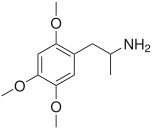Trimethoxyamphetamines (TMAs) are a family of isomeric psychedelic hallucinogenic drugs. There exist six different TMAs that differ only in the position of the three methoxy groups: TMA, TMA-2, TMA-3, TMA-4, TMA-5, and TMA-6. The TMAs are analogs of the phenethylamine cactus alkaloid mescaline. The TMAs are substituted amphetamines, however, their mechanism of action is more complex than that of the unsubstituted compound amphetamine, probably involving agonist activity on serotonin receptors such as the 5HT2A receptor in addition to the generalised dopamine receptor agonism typical of most amphetamines. This action on serotonergic receptors likely underlie the psychedelic effects of these compounds. It is reported that some TMAs elicit a range of emotions ranging from sadness to empathy and euphoria. TMA was first synthesized by Hey, in 1947.[1] Synthesis data as well as human activity data has been published in the book PiHKAL.
The most important TMA compound from a pharmacological standpoint is TMA-2, as this isomer has been much more widely used as a recreational drug and sold on the grey market as a so-called research chemical; TMA (sometimes referred to as "mescalamphetamine" or TMA-1) and TMA-6 have also been used in this way to a lesser extent. These three isomers are significantly more active as hallucinogenic drugs, and have consequently been placed onto the illegal drug schedules in some countries such as the Netherlands and Japan. The other three isomers TMA-3, TMA-4, and TMA-5 are not known to have been used as recreational drugs to any great extent.
TMAs
|
|
| ||||||||||||||||||||||||||||||||||||
|
|
| ||||||||||||||||||||||||||||||||||||
Note: Because they are isomers, the TMAs have the same chemical formula, C12H19NO3, and the same molecular mass, 225.28 g/mol.
Properties
| Compound | Pattern | Dose | Duration |
|---|---|---|---|
| TMA | 3,4,5 | 100 – 250 mg | 6 - 8 h |
| TMA-2 | 2,4,5 | 20 – 40 mg | 8 - 12 h |
| TMA-3 | 2,3,4 | > 100 mg | unknown |
| TMA-4 | 2,3,5 | > 80 mg | ~ 6 h |
| TMA-5 | 2,3,6 | ≥ 30 mg | 8 - 10 h |
| TMA-6 | 2,4,6 | 25 – 50 mg | 12 - 16 h |
Legality
Brazil
It is scheduled in the F2 class (prohibited psychotropics) of the Brazilian Controlled Drugs and Substances Act.[2]
Sweden
Sveriges riksdag added TMA-2 to schedule I ("substances, plant materials and fungi which normally do not have medical use") as narcotics in Sweden as of Dec 30, 1999, published by Medical Products Agency in their regulation LVFS 2004:3 listed as 2,4,5-trimetoxiamfetamin (TMA-2).[3]
United Kingdom
Illegal under the Psychoactive Substances Act 2016
United States of America
3,4,5-Trimethoxyamphetamine is listed as a Schedule 1 controlled substance, along with positional isomers 2,4,5-Trimethoxyamphetamine (TMA-5), 2,4,6-Trimethoxyamphetamine (TMA-6) and Escaline. [4]
See also
References
- ↑ Hey, P (1947). "The synthesis of a new homologue of mescaline". Quart. J. Pharm. Pharmacol. 20 (2): 129–134. PMID 20260568.
- ↑ Anvisa (2023-07-24). "RDC Nº 804 - Listas de Substâncias Entorpecentes, Psicotrópicas, Precursoras e Outras sob Controle Especial" [Collegiate Board Resolution No. 804 - Lists of Narcotic, Psychotropic, Precursor, and Other Substances under Special Control] (in Brazilian Portuguese). Diário Oficial da União (published 2023-07-25). Archived from the original on 2023-08-27. Retrieved 2023-08-27.
- ↑ http://www.lakemedelsverket.se/upload/lvfs/LVFS_2004-3.pdf
- ↑ https://www.deadiversion.usdoj.gov/schedules/orangebook/orangebook.pdf





